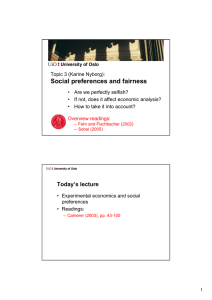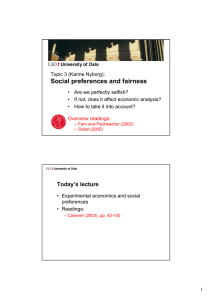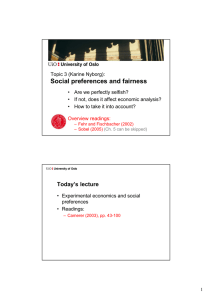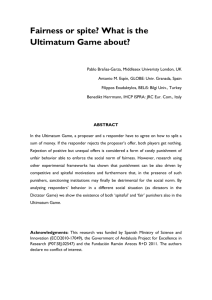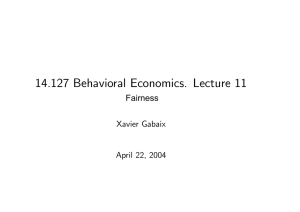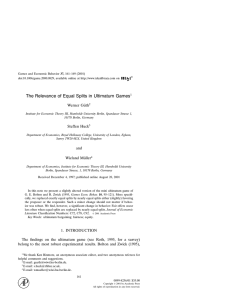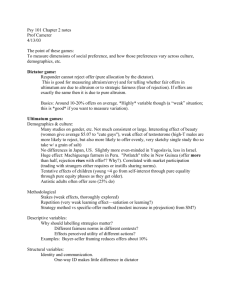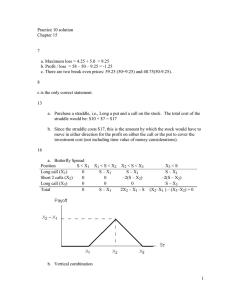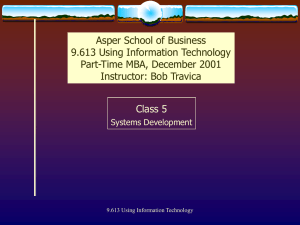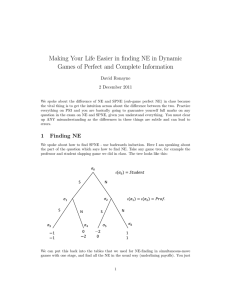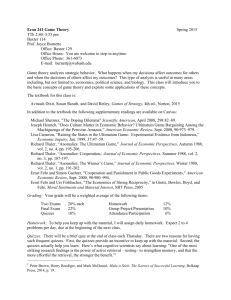Today’s lecture Social preferences and fairness Topic 3: Overview readings:
advertisement
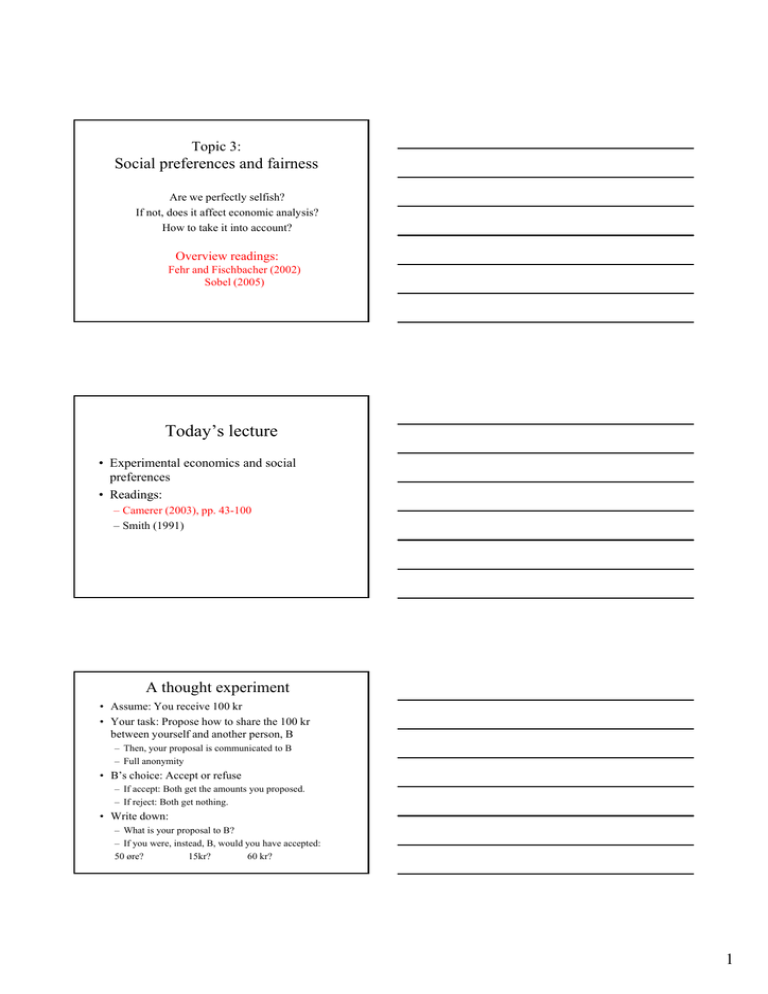
Topic 3:
Social preferences and fairness
Are we perfectly selfish?
If not, does it affect economic analysis?
How to take it into account?
Overview readings:
Fehr and Fischbacher (2002)
Sobel (2005)
Today’s lecture
• Experimental economics and social
preferences
• Readings:
– Camerer (2003), pp. 43-100
– Smith (1991)
A thought experiment
• Assume: You receive 100 kr
• Your task: Propose how to share the 100 kr
between yourself and another person, B
– Then, your proposal is communicated to B
– Full anonymity
• B’s
B’ choice:
h i Accept
A
or refuse
f
– If accept: Both get the amounts you proposed.
– If reject: Both get nothing.
• Write down:
– What is your proposal to B?
– If you were, instead, B, would you have accepted:
50 øre?
15kr?
60 kr?
1
Experimental economics
• Controlled environment, real incentives
• History of experimental economics
– 1960 + : First economics lab (V. Smith)
– 1980 + : Field takes off
– 2000 + : Field explodes
Lab and field experiments
• Laboratory experiments
– Voluntary, knowing participants
– Baseline case vs treatment cases: Change one variable
• Field experiments
– Naturally occurring environment, imperfect control
– Unknowing participants
– Baseline case vs treatment cases: Change one variable –
but: natural variation may occur
– Example: Effect on charitable giving of solicitation
methods (Lange et al.)
Economic vs. psychological experiments
• Cognitive and social psychology:
– Experiments from ca. 1900
• Differences in methodology:
– Payment
– Deception
p
2
The dictator game
• A : Dictator
• B: Recipient
• A gets amount X (ex. 100 NOK), decides how to
allocate X between A and B
• B: Passive recipient
X = xA + xB
Let s = B’s share of X as proposed by A
Let xi = i’s actual outcome
• If A cares only about his own monetary payoff: Which s
will he choose? (anonymity)
Experimental findings, dictator game
• Typical results (see Camerer 2003):
– Average offer (s) ≈ 0.2
– Offers of 0 and 0.4 – 0.5 most common
• The following tend to increase s:
– Non-anonymity
– ”Identifiable victim” (recipient has been determined)
– ”Deserving” recipient (e.g. Red Cross)
• The following tend to decrease s:
– ”Earned” initial amount
– Option to ”pass”
– Option to take
• Context dependency
The ultimatum game
•
•
Like dictator game, but B can reject A’s offer
–
–
1.
2.
3
3.
If B rejects: Both get zero.
If B accepts: Each gets the amount proposed by A.
A gets X
A offers B a share s
B accepts or rejects
4.
If accept, xA = (1-s)X and xB = sX.
If reject, xA = xB = 0.
If both care only about their own material
payoff: What will they do? (anonymity, oneshot)?
3
Self-interested utility maximers
• Assume 50 øre is the lowest strictly positive
amount
• A self-interested B will strictly prefer to accept
any strictly positive offer
• Foreseeing this, A will never offer more than 50
øre
• If A offers 50 øre, B will accept
• If A offers 0, B may still accept (has nothing to
gain by refusing)
• Prediction: Minimal offers, minimal rejections
The self-interest model (benchmark)
• Money – to myself – is all that counts
– (Or: If other things count, they are kept fixed in the lab)
• Person i cares only about her own income Wi :
(1) Ui = ui (Wi) = ui (Fi + xi )
where
h Fi = i’s
i’ exogenous (other
( th than
th lab)
l b) income,
i
xi = the material payoff of person i from the experiment
ui’ > 0 and ui’’ ≤ 0
• What is i’s benefit from the experiment?
• Differentiating (1): dUi = ui’ dWi = ui’ xi
• i’s benefit is proportional to xi (if xi marginal)
Equilibria: UG with self-interested players
• Nash equilibrium
– Set of strategies such that no player can profitably deviate from her
strategy, given the strategies of the other players.
• Example of NE: {s = 0.3, accept any s ≥ 0.3}
– B’s strategy to reject any offer below 30 percent is not credible
– If offered 10 percent, a self-interested B would prefer to accept!
• Subgame perfect Nash equilibrium
– Eli
Eliminates
i
N h equilibria
Nash
ilib i in
i which
hi h players’
l
’ threats
h
are not
credible (hint: backward induction)
– {s = 0.3, accept any s ≥ 0.3}: NE, not SPNE
• SPNE in ultimatum game with self-interested players:
– If 50 øre (s=0.005) is the smallest strictly positive amount:
{s = 0.005, accept any s > 0} is a SPNE
{s = 0, accept any s ≥ 0} is a SPNE
– If s is continuous:
{s = 0, accept any s ≥ 0} is the only SPNE.
4
• Did you propose more than 50 øre?
• Did you reject any offers?
Findings, ultimatum games
• Typical result (Camerer 2003):
– Average offer about 0.4
– Offers of 0.5 very common
– About half of offers < 0.2 are rejected
• Results robust to
– high stakes (up to several months’ wage)
– experience
• Varies with
– age
– culture
Cross-cultural studies
• Henrich et al. (2001): Ultimatum games in 17
small-scale societies, 5 continents
– Average offers: 0.26 to 0.58
– Rejection of small offers: Varies substantially
– No economy displays both average offers and rejection
rates close to zero
– More market integration: higher offers
– More economies of scale in local economy: higher
offers
– Average offers above 0.5:
• 0.51 (Ache, Paraguay), 0.58 (Lamelara, Indonesia)
• Norms of potlatch/competitive gift-giving
• ”Hyper-fair” offers: Frequently rejected
5
• Puzzle 1: Why do proposers share?
• Puzzle 2: Why do responders reject?
Another thought experiment
• You get 600 kr
• You are in a group with two other students
• How much will you contribute to your
ggroup?
oup?
• All contributions are doubled, then shared
equally between the 3 group members.
• Earnings: 600 kr – your contribution + your
share of total group contributions
• Double-blind
Competition in ultimatum games
• Real-world parallell: one seller, one buyer
• One seller, many buyers: Proposer competition
–
–
–
–
Several proposers make offers to a single responder
Responder accepts the highest offer
Proposers whose offers are not accepted get 0
Result (after some repetition): Almost all proposers
offer s ≈ 1
– Responder gets almost everything
• One buyer, many sellers: Responder competition
– One proposer makes offer s. If every responder rejects,
all receive 0. If at least one responder accepts, one
accepting responder is drawn randomly and receives a
share s, while proposer receives a share (1-s).
– Results (after some repetition): s ≈ 0
– Proposer gets almost everything
6
Vernon Smith (1991): Rational Choice: The
Contrast between Economics and Psychology
• Individuals often violate rational standard rational choice
assumptions in the lab
• Still, market institutions (e.g. competition, repetition) often
produce outcomes consistent with standard theory
• The market may work efficiently even if its participants
participants’
cognitive abilities are limited.
– ”(...) prices and allocations converge quickly to the neighborhood
of the predicted rational expectations competitive equilibrium,”
even if ”subjects are not aware that they are achieving maximum
profits collectively and individually, and, in fact, deny this when
asked (...). When asked what strategies they used, they are unable
to convey insight to the experimenter” (p.880-881).
• We need to test individuals acting within institutions
Purposes of experimental research
• Testing the predictions of existing theories
– Is the subgame perfect equilibrium reached in UG?
• Generating new theories
–
–
–
–
–
Unexplained regularities: look for explanations
Do responders reject because they prefer 0 to 0.20?
Or: a preference to punish the proposer?
Test the new hypotheses
Two-way interaction: Theory
experiments
• Studying behavior when theory has little to say
– Testing which is strongest of counteracting effects
Public good games
•
•
•
•
•
Groups of anonymous subjects (e.g. 4)
Each subject receives an amount of money, e
Choice: Divide e between oneself and the group
Simultaneous choice
All contributions
ib i
to the
h group are multiplied
l i li d by
b a
factor m (where 1< m < N), and then shared
equally between the N group members
• Contribution maximizing group payoff: e
• Contribution maximizing individual payoff, given
others’ contribution (only NE): 0
7
Typical finding, public good games
• One-shot, and first stages of repeated trials:
Subjects generally contribute about 40-60 %
– there are substantial contributions and free-riding
• Contributions decline with repetition
– often rather dramatically
• If players can punish each other (at a cost)
– Low contributors are punished
– Average contributions stay high, and may increase
(even to 100 percent, or close to 100 percent).
10
20
(mean) bidrag
30
40
50
See Camerer (2003), Fehr and Fischbacher (2002), Fehr and
Gächter (2002).
0
5
10
period
15
20
Pilot experiment:
Average contributions, by
period
8
Public good games
• Note: Misprint in Camerer (2003, p. 45):
– Endowment = e, contribution to group = ci
– Payoff to player i is
x i ei c i m ( k c k )
1
N
– Individual p
payoff
y maximized at ci = 0, g
group
p ppayoff
y
maximized at ci = e if
1<m<N
– (not m < (1/N) as claimed on p. 45. (correct expression
on p. 103; see also Fehr and Schmidt 1999, p.836. )
Trust games
•
Trust game: ”Two-way” dictator game where
–
–
•
1.
2.
3.
4.
5.
B gives A the initial allocation
The more B gives A to share, the higher is their total
B investor, A manager (cannot be monitored)
B gets an initial amount X
Gives T ≥ 0 of this to A. Keeps (X - T).
Investment T y
yields return ((1+r),
) so A earns ((1+r)T
)
A keeps Y of these earnings: Repays (1+r)T –Y to B.
Final payoffs:
xA = Y
xB = X – T +(1+r)T –Y = X – Y + rT.
•
•
T: measure of trust (or generosity?)
(1+r)T – Y: measure of trustworthiness (or generosity?)
The self-interest model: Predictions
• Anonymous one-shot game:
– If both A and B care only for their own material
payoff, what will they do?
• Backward induction
– In stage 4, A will give nothing to B:
Y = (1+r)T. No trustworthyness.
– Anticipating this, B will keep everything in
stage 2
T = 0, no trust
9
Typical findings, trust games
• Subjects invest about half of their endowment
– T ≈ X/2 > 0
– There is (some) trust
• Repayment about equal, or slightly less than,
investment T
(1+r)T – Y ≈ T > 0 (that is: Y ≈ rT)
– There is (some) trustworthiness
– But: not quite enough to make investments pay (that
would require repayments greater than investment)
Experiments on sharing, voluntary
contributions, fairness and trust
• Compared to the predictions of the self-interest
model, experiments find that people
– share more
– trust more
– sanction more
• Sharing and sanctioning: conditional on others’
behavior, perceived intentions:
– Kindness often repaid by kindness
– Unfairness often repaid by (costly) sanctions
• Heterogeneity:
– Some ”egoists”, few ”angels”, many ”reciprocators”
Next time
• Inequity aversion
• Readings:
– Fehr and Schmidt (1999)
– Camerer, C. (2003), pp. 101-104 (compendium)
– Sobel (2005), pp 398-401
10
